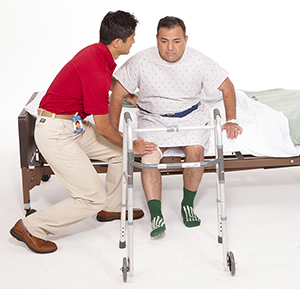After Knee Replacement: Hospital Recovery
Your healthcare team will help you get up soon after surgery. They will show you how to sit up, stand, and use the bathroom safely. You’ll also spend time in bed. Use this time to do exercises as directed by your healthcare team. When lying down, place a rolled-up towel under your ankle to help straighten your knee. Don't put a rolled-up towel or pillow under the knee itself.
Sitting up
The first few times you sit up, a healthcare provider will help you move your leg. Soon, you’ll be able to sit by yourself at the edge of the bed with your feet touching the floor.
Standing with support
A healthcare provider will help you stand. A safety belt may be placed around your waist to prevent a fall. A knee immobilizer may be put on your leg to protect the knee as you stand and use a walker.

Going to the bathroom
At first, you’ll be helped to the bathroom. Later, you’ll go on your own with a walker, but only after your healthcare team determines that it's safe for you to go alone. A commode chair over the toilet helps make sitting easier. The toilet seat will be raised to make sitting easier. To use it, follow these steps:
-
Back up until you feel the back of your legs touch the commode.
-
With your weight on your unoperated leg, place the operated leg in front of you. Reach back for the armrest. Lower yourself onto the commode.
-
To stand up, push up using the armrest, keeping your weight on your unoperated leg.
Online Medical Reviewer:
Rahul Banerjee MD
Online Medical Reviewer:
Raymond Turley Jr PA-C
Online Medical Reviewer:
Stacey Wojcik MBA BSN RN
Date Last Reviewed:
4/1/2024
© 2000-2024 The StayWell Company, LLC. All rights reserved. This information is not intended as a substitute for professional medical care. Always follow your healthcare professional's instructions.